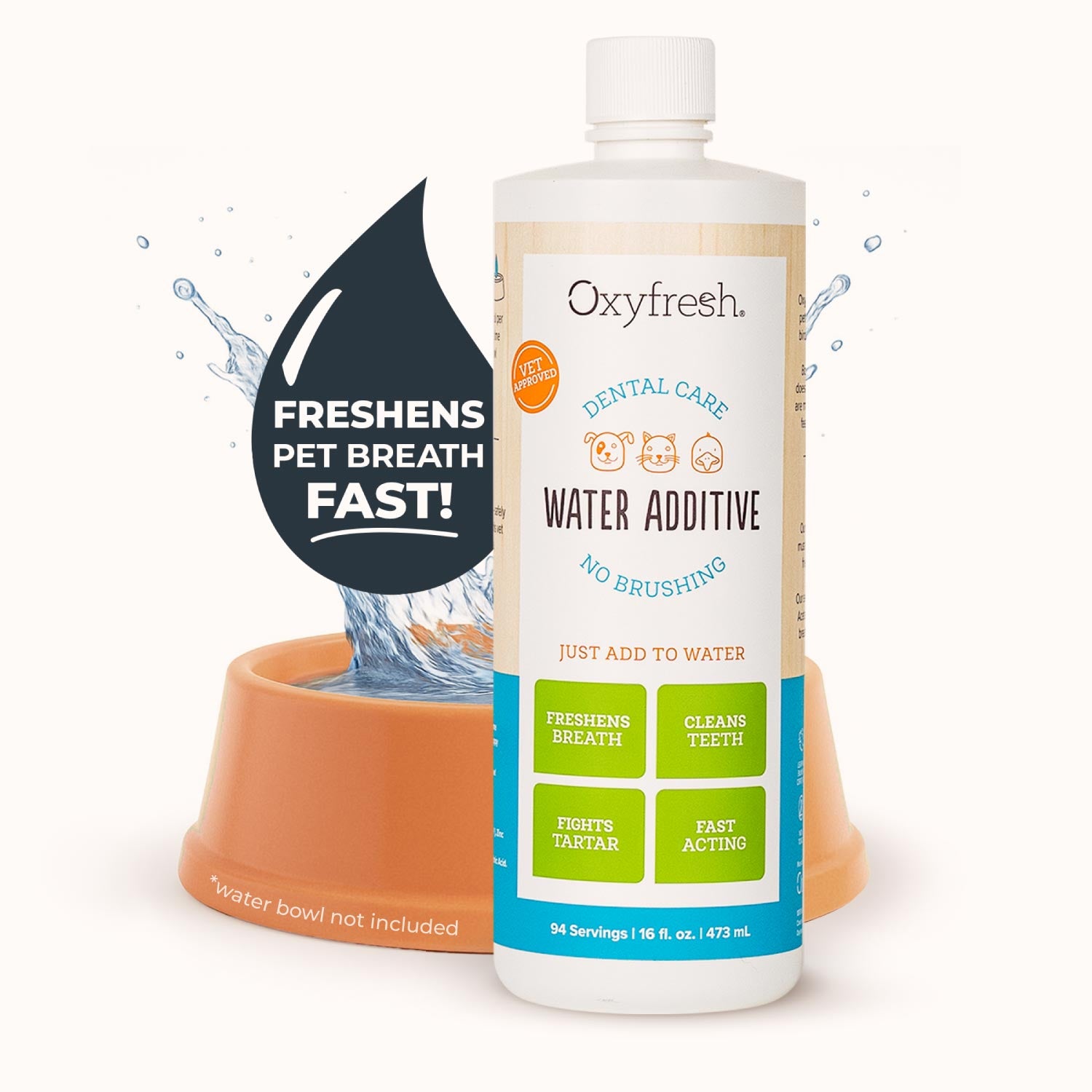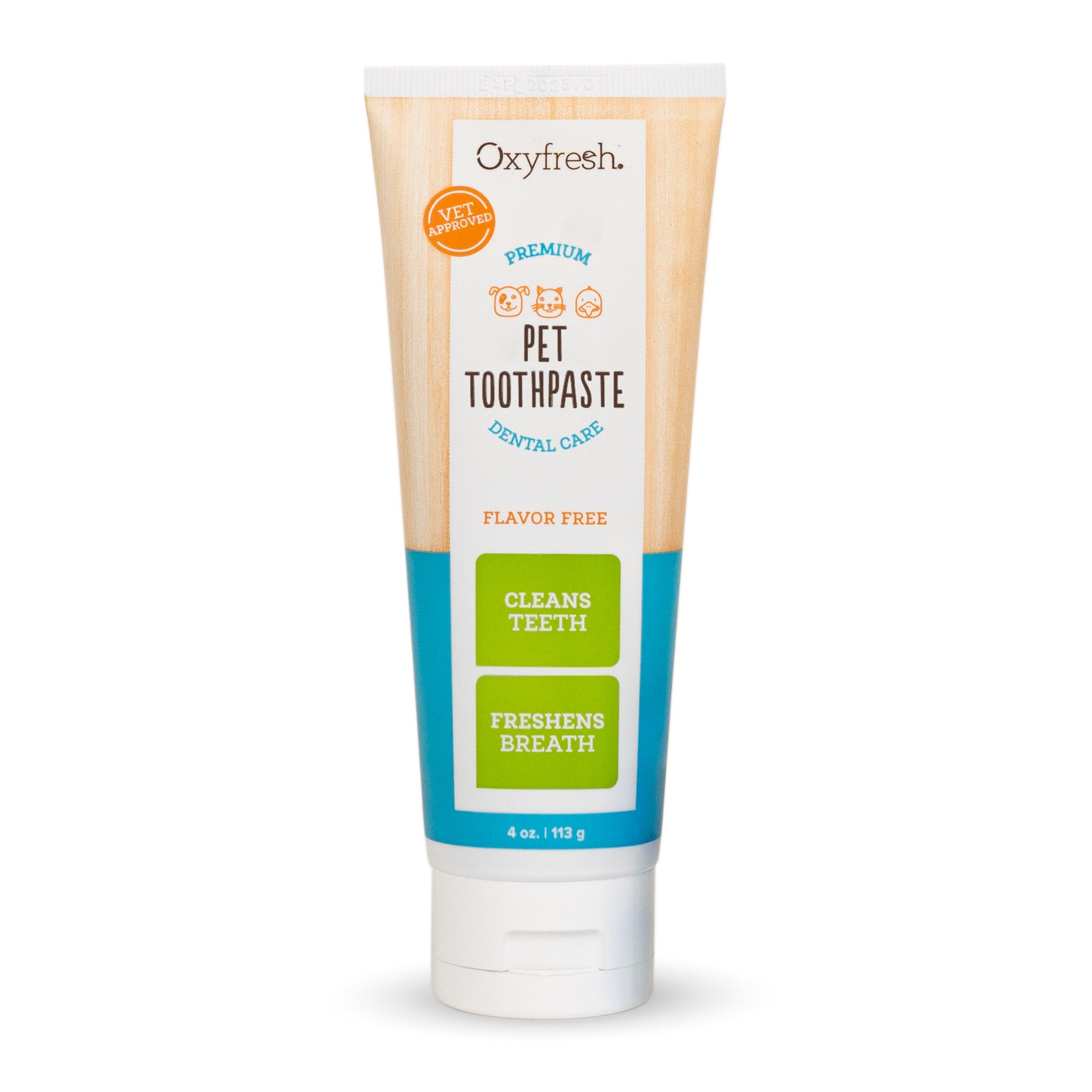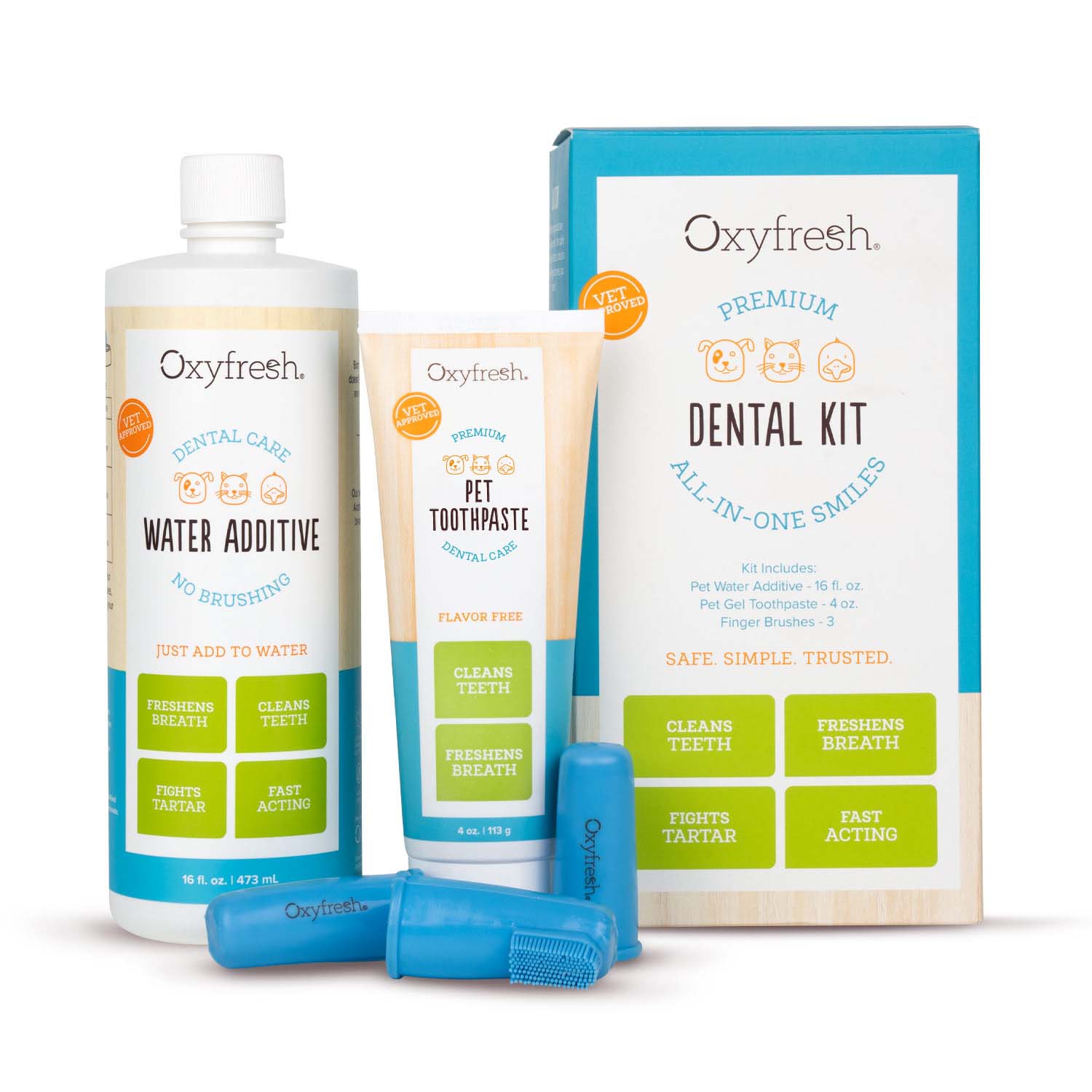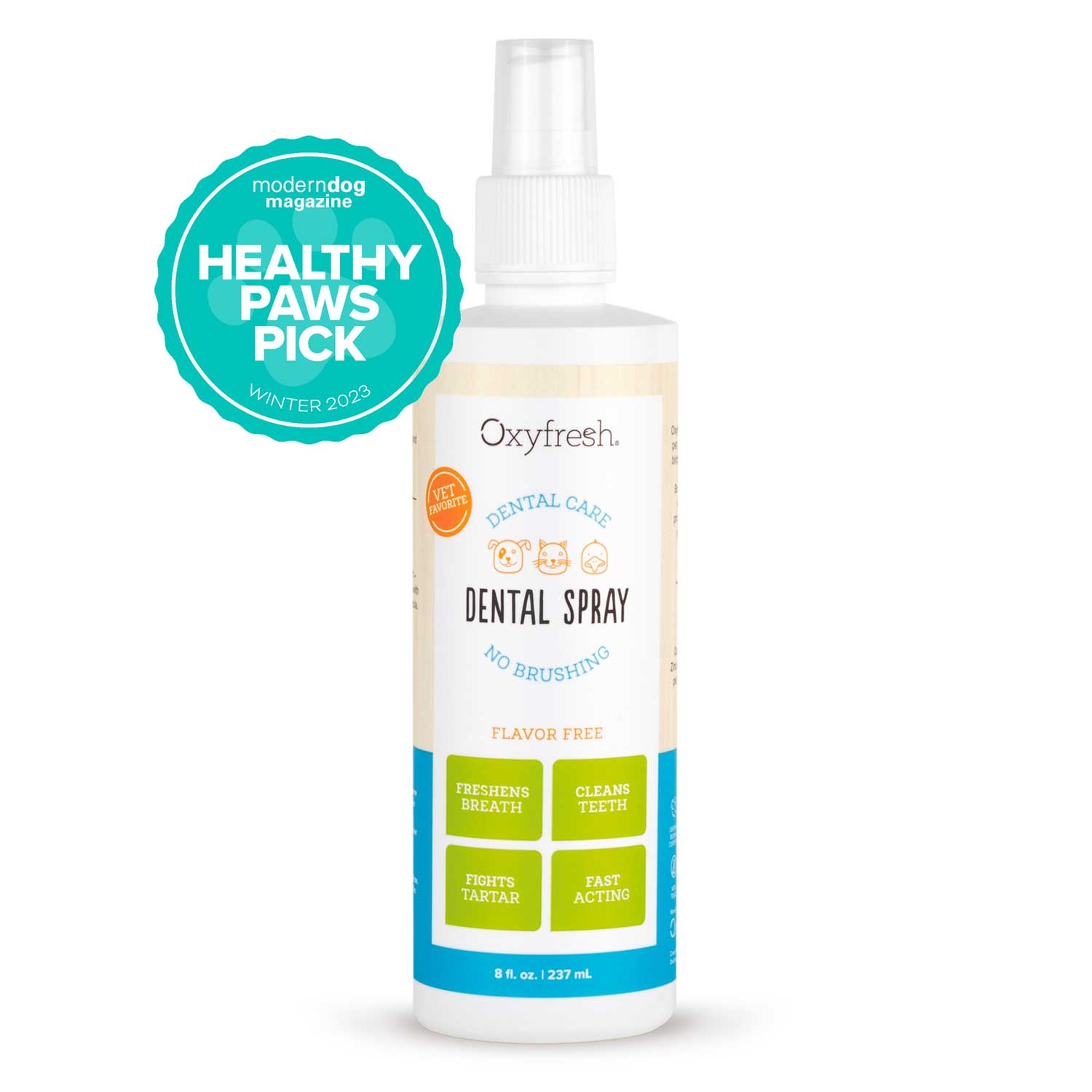We’ve all been there: cuddling with our furry besties when, BAM! A blast of fishy dog breath hits us like a freight train. Sure, fishy dog breath can be expected if they just wolfed down some salmon dog food or a tuna treat, but on a regular basis? That smells – ‘er, spells – trouble for your dog’s oral health.
How can you fix fishy dog breath without adding too much drama into your daily life? Read on to learn about water additives for dogs and other easy natural breath remedies.
What Causes Fishy Dog Breath?
The most common cause of fishy dog breath is a buildup of bacteria in the mouth – found in plaque and tartar. Plaque forms on a dog’s teeth after they eat, and if it’s left to sit there, it starts to harden into tartar (calculus) within a few days. Bacterium in plaque and tartar is smelly, hence, that fishy dog breath.
Though not as common as poor dental care, sometimes gastrointestinal issues or health problems like kidney disease or diabetes can cause smelly dog breath. Whatever the cause, it’s important to not equate fishy dog breath as a normal thing for dogs ... it’s not and ignoring the problem can be detrimental to your dog’s health and well-being.
Does Fishy Breath Mean My Dog Has Gum Disease?
Most likely, yes. Smelly, fishy dog breath is often the first gum disease (periodontal disease) symptom that pet parents notice. But don’t let the word disease scare you. There are four stages of periodontal disease in pets, and the early gingivitis stage is reversible right at home with good oral care. However, if your dog has thick tartar buildup, only a professional dental cleaning at the vet using scaling tools will remove it and give your dog a fresh start.
Beyond fishy dog breath: other signs of gum disease
- Red, inflamed gums
- Thin red line along the gums
- Bleeding gums (often noticeable on chew toys)
- Chewing on one side of the mouth or dropping food
- Not wanting to be touched around the mouth
- Yellow-brown tartar buildup, especially on the back molars
In the later stages of gum disease, the teeth become loose or even fall out, as bacteria from a gum infection erodes the bones that hold the teeth in place. As you can imagine, this is very painful for our four-legged friends.
How to Fix Fishy Dog Breath If You Don't Want to Brush
Brushing is the gold standard of dog dental care, but according to a poll of 592 dog parents, only 7% brush their pooches’ teeth daily. If you want to give it a try, more power to you. (Just don’t try to wing it; read this first: How to Brush Your Dog’s Teeth ... Without Losing Your Sanity.)
But for the rest of us, there’s no shame in saying it: sometimes it’s a struggle to brush our own teeth twice a day for two minutes. (Two minutes if we’re counting at lightning speed, that is!) Add the responsibility of brushing your dog’s teeth and it can feel overwhelming, ESPECIALLY if your dog doesn’t like it and tries to squirm away, run to the other room, wrestle you, or dodge your grip.
Don’t worry; there are other methods you can employ to help get your dog’s teeth clean and freshen their breath.
Coconut oil for dog's teeth
Coconut oil packs a lot of health benefits for both people and pets. For oral health, it’s renowned for its antimicrobial properties. In particular, the lauric acid inside coconut oil can help eliminate harmful bacteria, leading to less plaque buildup and fresher dog breath. Plus, dogs love the taste. (Just don’t go crazy with it or your dog could get diarrhea.)
You can use coconut oil for your dog’s teeth in a few different ways:
- Add a small spoonful to your dog’s food.
- If you want to try brushing their teeth, use it as a toothpaste.
- Apply coconut oil to a dental chew toy and let your dog do their thing. The toy should have ridges or nubs, so they get some good scraping action on their teeth.
Yogurt dog bad breath remedy
Yogurt acts as a dog bad breath remedy by helping to balance your pup’s gut microbiome (good bacteria vs. bad bacteria) due to the probiotics inside. This can help tackle bad dog breath coming from the gut.
Yogurt serving sizes for dogs:
- Small dogs: 1 spoonful daily
- Medium dogs: 2 spoonfuls daily
- Large dogs: 3 spoonfuls daily
Note: Yogurt consumption should never be more than 10% of your dog's caloric intake.
Before using yogurt as a dog bad breath remedy, keep the following in mind:
- Yogurt oftentimes causes digestive issues in dogs because it contains lactose, which many dogs are intolerant to. So if you don’t want to clean up messes on the carpet or deal with runny poop piles in the backyard, go easy with it at first.
- Only give your dog plain, unsweetened yogurt. Many yogurt varieties are filled with excess sugar, and all that sugar on a dog’s teeth will ironically lead to more bacteria or even the rare phenomenon of a dog cavity.
- Read labels carefully and beware of phrasing like sugar free and low calorie. This usually means there are artificial sweeteners in the formulas or xylitol, a natural sweetener that’s very toxic to dogs.
Parsley or mint sprinkled over dog food
If you have a green thumb or bought parsley for a dish and don’t want to waste any of it, sprinkle these greens – after you’ve finely chopped them – over your dog’s food. The chlorophyll inside has deodorizing properties that will help fix your dog’s fishy breath. (It won’t do much for plaque though, so this is more for breath maintenance – not a sub for regular oral care.) Mint brings the same benefits as parsley, although many dogs don’t like the taste of it, so keep your expectations in check.
Bones & Dental Toys
Raw bones have natural plaque-fighting enzymes, and the chewing motion acts as a floss for a dog’s teeth, helping to remove filmy plaque. The downside to bones is they can be messy, and if your dog is in the advanced stages of periodontal disease, their teeth may be too loose to safely chew on bones. Same goes for toys. You don’t want anything too hard that can damage your dog’s teeth. Ideally, you’ll want to get a rubber toy that has ridges to clean their teeth, like Oxyfresh's Dog Dental Chew. Its strong rubber resists tearing (perfect for the power chewers) and it promotes healthy gums with daily use. Bonus if you apply some pet toothpaste to the dental chew toy, as it will act as a natural toothbrush.
Water Additives for Dogs: The Best No-Brush Fix for Fishy Dog Breath
If you’re among the 93% of dog parents who aren’t brushing their dog’s teeth daily, don’t worry! You can still give your dog similar benefits, minus the hassle, with a water additive for dogs. It makes daily dog dental care a walk in the park: just add into your dog’s water bowl and you’re good to go!
When choosing a water additive, flavor free is the way to roll so your dog doesn’t turn their nose up at the water dish. (That’s the biggest complaint surrounding water additives: My dog won’t drink his water!) Also avoid water additives with the bacteria-fighter chlorhexidine gluconate, which has a bitter taste and can upset a dog’s stomach.
Oxyfresh Water Additive for Dogs is the best choice because it outsmarts all the picky pets! It’s free of flavors, scents, and dyes, and formulated with proprietary Oxygene® (stabilized chlorine dioxide), a non-toxic oxidizer that eliminates the bacteria that cause dog plaque and bad breath right at the source. No coverups with mint, clove, green tea or other odd flavors. It’s safe, gentle, effective, and best of all, works instantly to freshen fishy dog breath.
Combined with zinc acetate, a safe, proven dental ingredient that helps fight plaque, you have a dynamic duo in Oxyfresh Water Additive to protect your dog from the perils of periodontal disease with every drink of water!
Is stabilized chlorine dioxide safe for dogs?
Yes, stabilized chlorine dioxide is safe for dogs. (If you have a dog with a notoriously finicky stomach, you can always start out with half-dose amounts.) In fact, this ingredient is renowned for its safety and effectiveness and has been used to purify public drinking water since the 1970s.
Stabilized chlorine dioxide for dog dental care works just as well as chlorhexidine gluconate at eliminating harmful bacteria, but without the undesirable side effects like bitter taste and stomach upset.
Count on Oxyfresh Water Additive’s proprietary blend of stabilized chlorine dioxide (Oxygene®) to bring peace of mind and help fix fishy dog breath, fast, without all the fuss and flavors.
Try it today and see why it’s the most popular water additive for dogs on the market!









